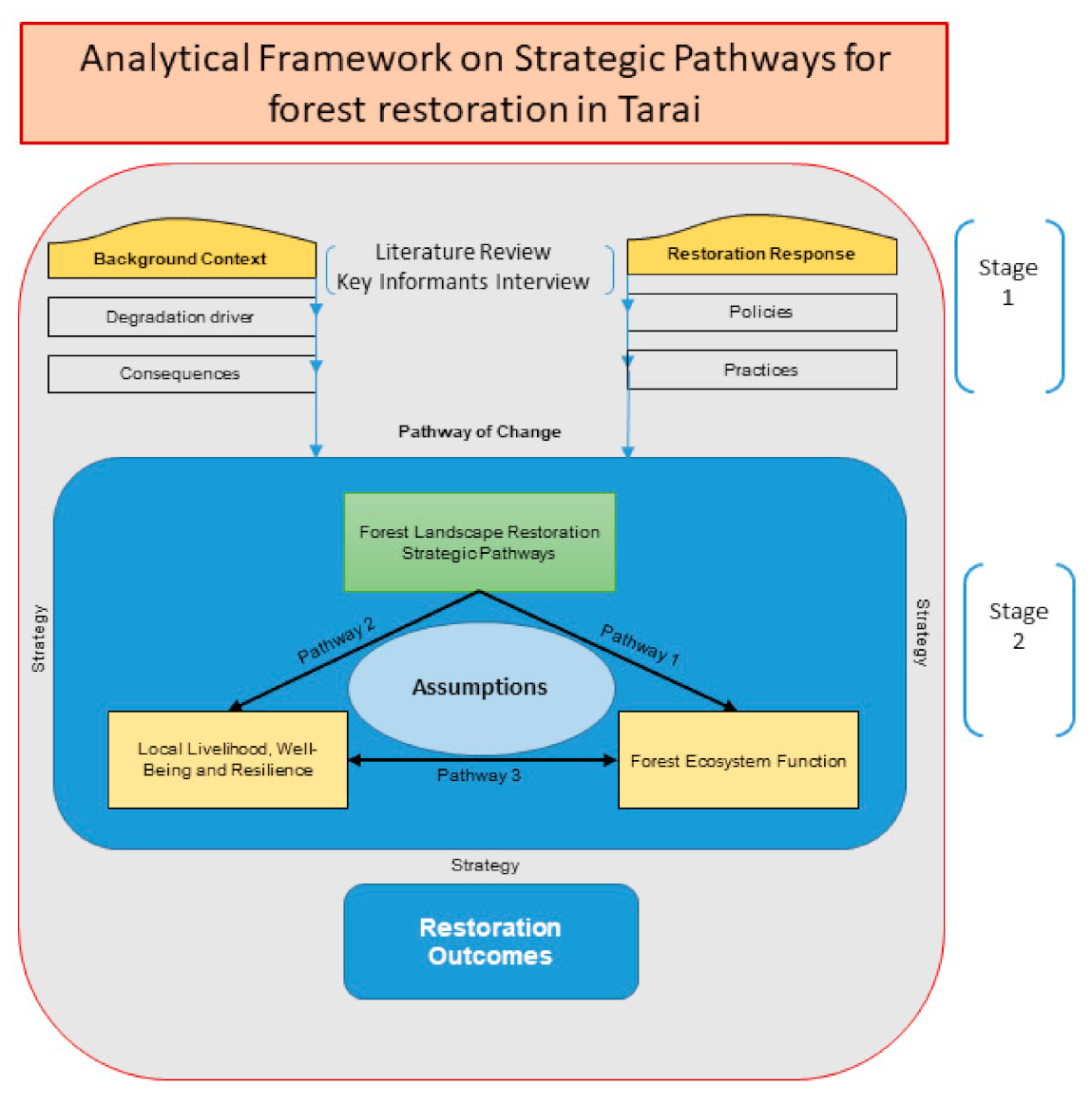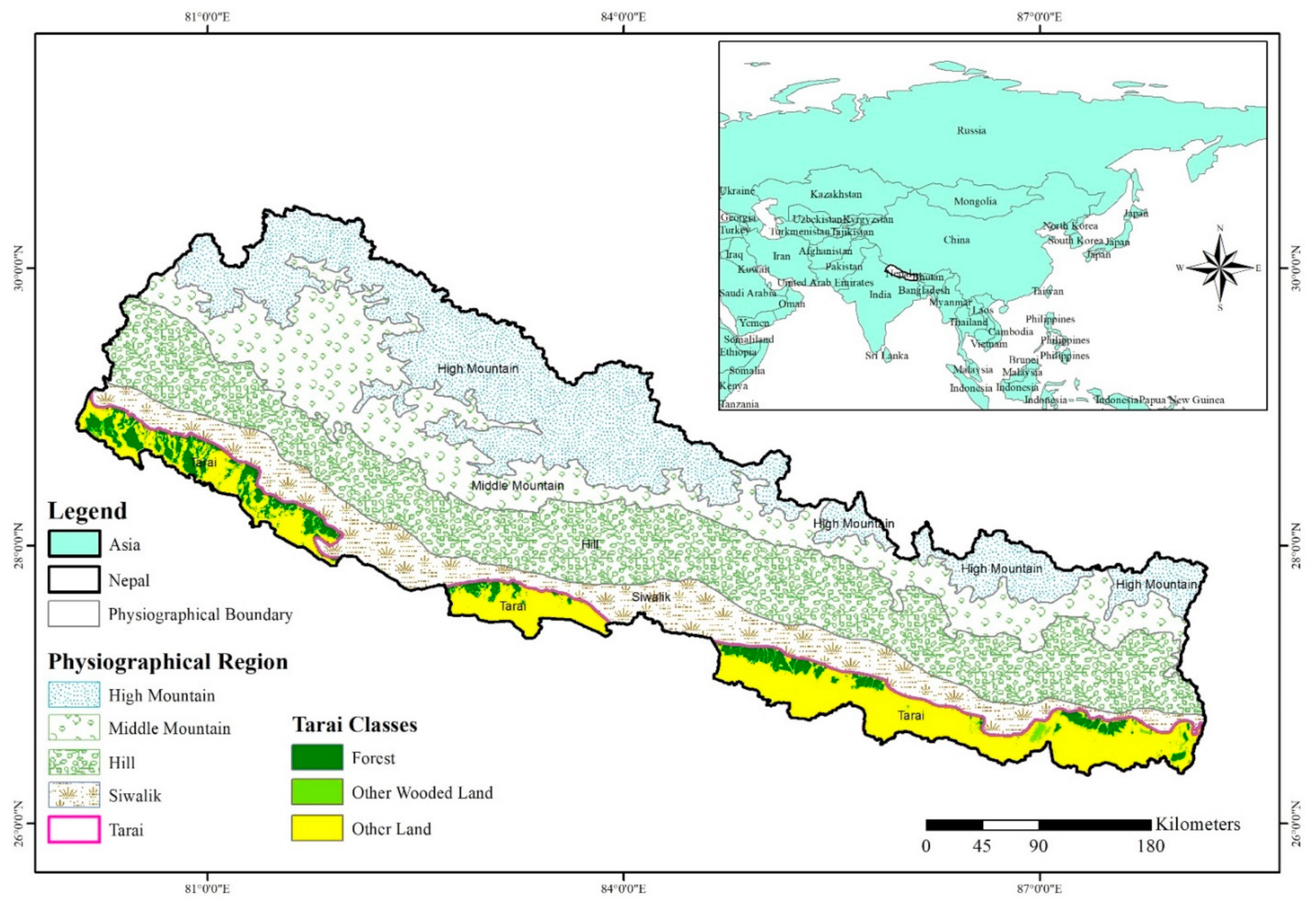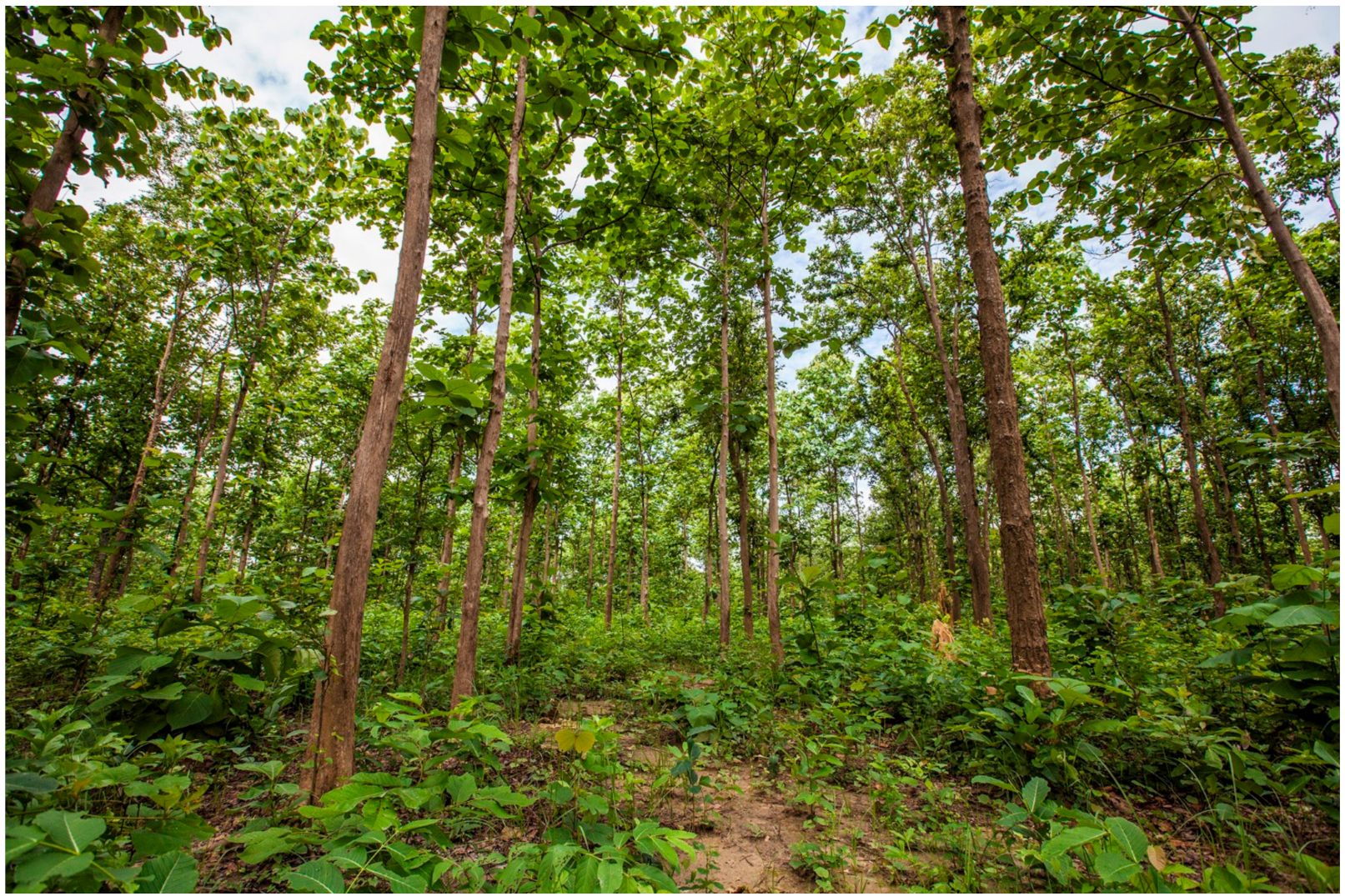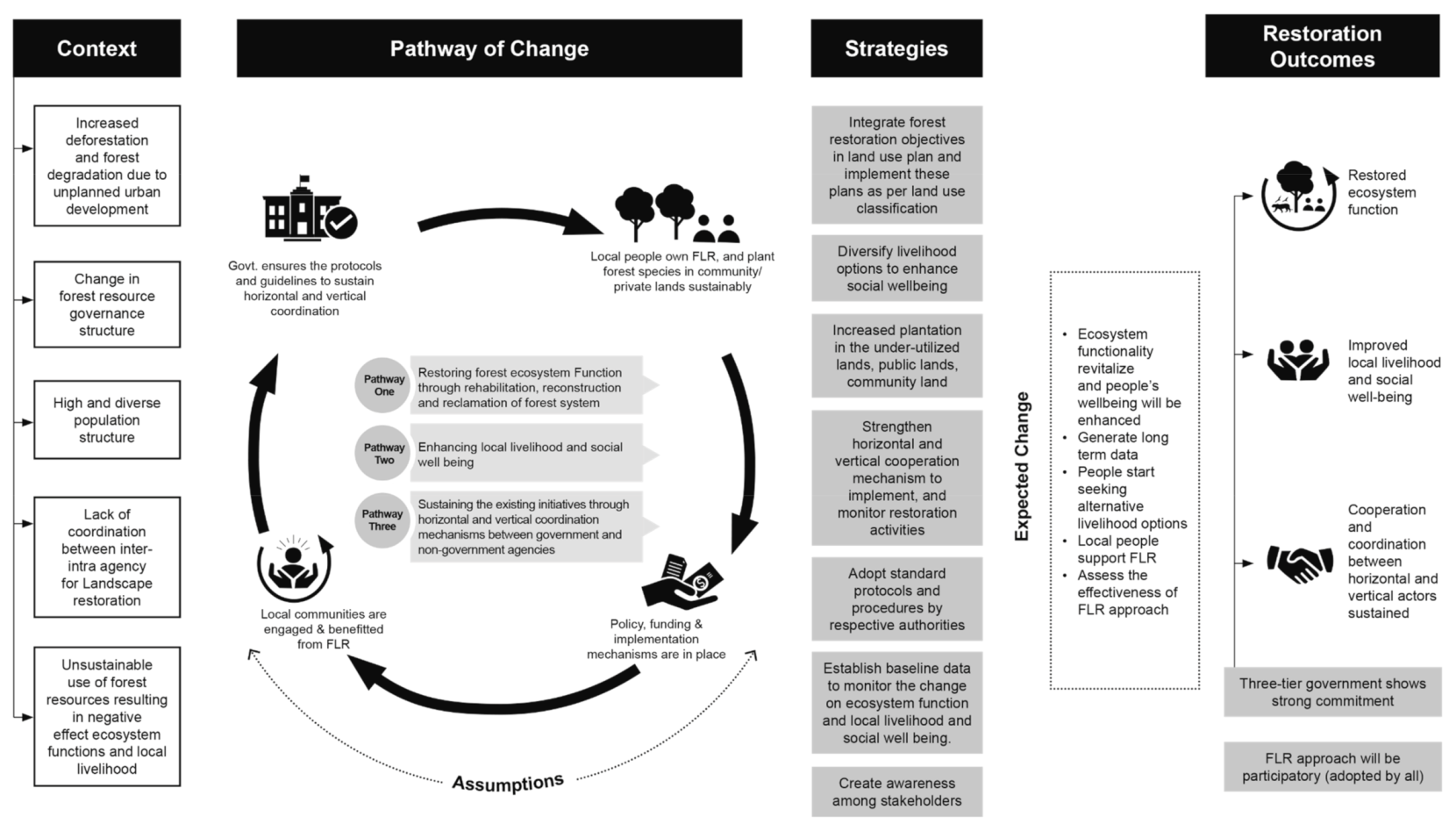Strategic Pathways to Scale up Forest and Landscape Restoration: Insights from Nepal’s Tarai
Abstract
1. Introduction
2. Analytical Framework
3. Context of Nepal’s Tarai
4. Policy Discourse and Its Interaction with Forest Degradation and Restoration Outcomes: A Decadal Analysis
5. Pathways for Achieving FLR Outcomes
5.1. Pathways of Change
5.1.1. Restoring Forest Ecosystem Functions through Rehabilitation, Reconstruction, and Reclamation of Forest Systems
5.1.2. Enhancing Local Livelihood and Social Wellbeing
5.1.3. Sustaining the Existing Initiatives through a Horizontal and Vertical Coordination Mechanism Between Government and Non-Governmental Agencies
5.2. Strategies for Development
5.2.1. Integrate Forest Restoration Objectives in Land Use Planning and Implement These Plans as per Land Use Classification
5.2.2. Diversify Livelihood Options to Enhance Social Wellbeing
5.2.3. Increase Plantation in the Underutilized Public and Community Lands
5.2.4. Strengthen Horizontal and Vertical Cooperation Mechanisms to Implement and Monitor Restoration Activities
5.2.5. Adopt Standard Protocols and Procedures among Authorities
5.2.6. Establish Baseline Data to Monitor the Change in Ecosystem Function and Local Livelihood and Social Wellbeing
5.2.7. Create Awareness among Stakeholders
6. Conclusions
Author Contributions
Funding
Institutional Review Board Statement
Informed Consent Statement
Data Availability Statement
Acknowledgments
Conflicts of Interest
References
- Mukul, S.A.; Halim, M.A.; Herbohn, J. Forest Carbon Stock and Fluxes: Distribution, Biogeochemical Cycles, and Measurement Techniques. In Life on Land, Encyclopedia of the UN Sustainable Development Goals; Filho, W.L., Azul, A.M., Brandli, L., Salvia, A.L., Wall, T., Eds.; Springer: Cham, Switzerland, 2021; pp. 361–376. ISBN 9783319710655. [Google Scholar]
- Chazdon, R.L. Beyond deforestation: Restoring forests and ecosystem services on degraded lands. Science 2008, 320, 1458–1460. [Google Scholar] [CrossRef]
- Lewis, S.L.; Edwards, D.P.; Galbraith, D. Increasing human dominance of tropical forests. Science 2015, 349, 827–832. [Google Scholar] [CrossRef] [PubMed]
- Landell-mills, N.; Porras, I.T. Silver Bullet or Fools’ Gold? A Global Review of Markets for Forest Environmental Services and Their Impact on the Poor. In Instruments for Sustainable Private Sector Forestry Series; International Institute for Environment and Development (IIED): London, UK, 2002. [Google Scholar]
- Erbaugh, J.T.; Oldekop, J.A. Forest landscape restoration for livelihoods and well-being. Curr. Opin. Environ. Sustain. 2018, 32, 76–83. [Google Scholar] [CrossRef]
- MEA. Ecosystems and Human Well-Being: Synthesis; Island Press: Washington, DC, USA, 2005; ISBN 1597260401. [Google Scholar]
- Chazdon, R.; Brancalion, P. Restoring forests as a means to many ends: An urgent need to replenish tree canopy cover calls for holistic approaches. Science 2019, 364, 24–25. [Google Scholar] [CrossRef]
- Ota, L.; Chazdon, R.L.; Herbohn, J.; Gregorio, N.; Mukul, S.A.; Wilson, S.J. Achieving quality forest and landscape restoration in the tropics. Forests 2020, 11, 820. [Google Scholar] [CrossRef]
- CBD. Report of the Tenth Meeting of the Conference of the Parties to the Convention on Biological Diversity, Tenth Meeting, Nagoya, Japan, 18–29 October 2010; Agenda item 5.4; United Nation Environment Program: Nagoya, Japan, 2010. [Google Scholar]
- CBD. Decision Adopted by the Conference of the Parties to the Convention on Biological Diversity at its Seventh Meeting; United Nation Environment Program: Kuala Lumpur, Malaysia, 2004. [Google Scholar]
- UNFCCC. Report of the Conference of the Parties on Its Fifteenth Session, Held in Copenhagen from 7 to 19 December 2009, Addendum, Part Two: Action Taken by the Conference of the Parties at Its Fifteenth Session; United Nations: Copenhagen, Denmark, 2009. [Google Scholar]
- UN. New York Declaration on Forests: Declaration and Action Agenda 2014; United Nations: New York, NY, USA, 2014; p. 17. [Google Scholar]
- NPC. Nepal’s Sustainable Development Goals, Baseline Report; Government of Nepal: Kathmandu, Nepal, 2017. [Google Scholar]
- IUCN. Bonn Challenge: Impact and Potential of Forest Landscape Restoration; IUCN: Gland, Switzerland, 2020. [Google Scholar]
- Chazdon, R.L.; Herbohn, J.; Mukul, S.A.; Gregorio, N.; Ota, L.; Harrison, R.D.; Durst, P.B.; Chaves, R.B.; Pasa, A.; Hallett, J.G.; et al. Manila declaration on forest and landscape restoration: Making it happen. Forests 2020, 11, 685. [Google Scholar] [CrossRef]
- Bastin, J.-F.; Finegold, Y.; Garcia, C.; Mollicone, D.; Rezende, M.; Routh, D.; Zohner, C.M.; Crowther, T.W. The global tree restoration potential. Science 2019, 366, 76–79. [Google Scholar] [CrossRef]
- Suding, K.; Higgs, E.; Palmer, M.; Callicott, J.B.; Anderson, C.B.; Baker, M.; Gutrich, J.J.; Hondula, K.L.; LaFevor, M.C.; Larson, B.M.H.; et al. Committing to ecological restoration. Science 2015, 348, 638–640. [Google Scholar] [CrossRef] [PubMed]
- Chazdon, R.L. Making Tropical Succession and Landscape Reforestation Successful. J. Sustain. For. 2013, 32, 649–658. [Google Scholar] [CrossRef]
- Laudari, H.K.; Aryal, K.; Bhusal, S.; Maraseni, T. What lessons do the first Nationally Determined Contribution (NDC) formulation process and implementation outcome provide to the enhanced/updated NDC? A reality check from Nepal. Sci. Total Environ. 2020, 759, 143509. [Google Scholar] [CrossRef]
- MOFE. Annual Progress Report FY 2075/076 (2018/19); Ministry of Forests and Environment: Kathmandu, Nepal, 2019. [Google Scholar]
- DFRS. State of Nepal’s Forests, 5th ed.; Department of Forest Research and Survey (DFRS): Kathmandu, Nepal, 2015. [Google Scholar]
- Mukul, S.A.; Byg, A. What determines indigenous Chepang farmers’ Swidden land-use decisions in the central hill districts of Nepal? Sustainability 2020, 12, 5326. [Google Scholar] [CrossRef]
- World Resources Institute Global Forest Watch: Tree Cover Loss in Nepal. Available online: https://www.globalforestwatch.org (accessed on 28 April 2021).
- MoFSC. Nepal’s Readiness Preparation Proposal REDD (2010–2013); Ministry of Forests and Environment: Kathmandu, Nepal, 2010. [Google Scholar]
- Rai, R.K.; Nepal, M.; Karky, B.S.; Somanathan, E.; Timalsina, N.; Khadayat, M.S.; Bhattarai, N. Costs and Benefits of Reducing Deforestation and Forest Degradation in Nepal; REDD Implementation Centre: Kathmandu, Nepal, 2017. [Google Scholar]
- NPC. 15th Five Year Plan (2019–2023): Approach Paper; National Planning Commission, Government of Nepal, Singhadurbar: Kathmandu, Nepal, 2019. [Google Scholar]
- FRA/DFRS. Terai Forests of Nepal 2010–2012; Department of Forest Research and Survey: Kathmandu, Nepal, 2014; Volume 53. [Google Scholar]
- CBS. Nepal Census 2011 District Profiles (Demography); Central Bureau of Statistics, Government of Nepal: Kathmandu, Nepal, 2011. [Google Scholar]
- GON. President Chure-Tarai Madhesh Conservation and Management Master Plan; Ministry of Forests and Environment: Kathmandu, Nepal, 2017. [Google Scholar]
- DFRS. Forest Cover Maps of Local Levels (753) of Nepal; Department of Forest Research and Survey: Kathmandu, Nepal, 2018. [Google Scholar]
- UNEP/FAO. The UN Decade on Ecosystem Restoration 2021–2030; United Nations: New York, NY, USA, 2019. [Google Scholar]
- Ministry of Forest and Soil Conservation. Nepal Biodiversity Strategy; Ministry of Forests and Soil Conservation, HMGN: Kathmandu, Nepal, 2002. [Google Scholar]
- Ghimire, M. Historical land covers change in the chure-tarai landscape in the last six decades: Drivers and environmental consequences. In Springer Geography; Springer Nature: Singapore, 2017; pp. 109–147. ISBN 9789811028908. [Google Scholar]
- GON. Carbon Fund Emission Reductions Program Document (ER-PD); Government of Nepal: Kathmandu, Nepal, 2018. [Google Scholar]
- Adhikari, J.; Dhungana, H. The State and Forest Resources: An Historical Analysis of Policies Affecting Forest Management in the Nepalese Tarai. J. Assoc. Nepal Himal. Stud. 2010, 29, 4. [Google Scholar]
- MOFE. Nepal National REDD+ Strategy; Ministry of Forests and Environment: Kathmandu, Nepal, 2018. [Google Scholar]
- Laudari, H.K.; Aryal, K.; Maraseni, T. A postmortem of forest policy dynamics of Nepal. Land Use Policy 2020, 91, 104338. [Google Scholar] [CrossRef]
- Pandit, R.; Bevilacqua, E. Forest users and environmental impacts of community forestry in the hills of Nepal. For. Policy Econ. 2011, 13, 345–352. [Google Scholar] [CrossRef]
- Stewart, J. Forest Policy in Nepal: Implications for Social Forestry; Oversees Development Institute: London, UK, 1986. [Google Scholar]
- Guthman, J. Representing Crisis: The Theory of Himalayan Environmental Degradation and the Project of Development in Post-Rana Nepal. Dev. Chang. 1997, 28, 45–69. [Google Scholar] [CrossRef]
- Malla, Y.B. Changing policies and the persistence of patron-client relations in Nepal: Stakeholders’ responses to changes in forest policies. Environ. Hist. 2001, 6, 287–307. [Google Scholar] [CrossRef]
- Bampton, J.F.R.; Ebregt, A.; Banjade, M.R. Collaborative Forest Management in Nepal’s Terai: Policy, Practice and Contestation. J. For. Livelihood 2007, 6, 30–43. [Google Scholar]
- Rai, R.K. Nepal’s Terai Forest Management: An Ethical View. In Paper Submitted for Seminar Period (March 2007); University of Joensuu: Joensuu, Finland, 2007. [Google Scholar]
- MFSC. Forest Sector Policy 2000; Ministry of Forests and Soil Conservation: Kathmandu, Nepal, 2000. [Google Scholar]
- MOFE. Forest Policy Nepal 2019; Ministry of Forests and Environment: Kathmandu, Nepal, 2019. [Google Scholar]
- HMGN. Private Forests (Nationalization) Act, 1957; Nepal Gazette: Kathmandu, Nepal, 1957; pp. 1–2. [Google Scholar]
- Ives, J.D.; Messerli, B. The Himalayan Dilemma: Reconciling Development and Conservation; United Nations University Press: London, UK; New York, NY, USA, 1989. [Google Scholar]
- MOFE. National Biodiversity Strategy and Action Plan 2014–2020; Ministry of Forests and Environment: Kathmandu, Nepal; Government of Nepal: Kathmandu, Nepal, 2014.
- MoLRM. Land Use Policy 2015; Ministry of Land Reform and Management: Kathmandu, Nepal; Government of Nepal: Kathmandu, Nepal, 2015. [Google Scholar]
- GoN/MFSC. Forestry Sector Strategy (2016–2025); Ministry of Forests and Soil Conservation: Kathmandu, Nepal, 2016. [Google Scholar]
- Bhattarai, S.; Pant, B.; Timalsina, N. Conservation without Participation: Detrimental Effect of Escaping People’s Participation in Protected Area Management in Nepal. In Protected Areas: Policies, Management and Future Directions; Mukul, S.A., Rashid, A.Z.M.M., Eds.; Nova Science Publishers: New York, NY, USA, 2017; pp. 83–104. [Google Scholar]
- Aryal, K.; Laudari, H.K.; Ojha, H.R. To what extent is Nepal’s community forestry contributing to the sustainable development goals? An institutional interaction perspective. Int. J. Sustain. Dev. World Ecol. 2020, 27, 28–39. [Google Scholar] [CrossRef]
- Bhattarai, S.; Pant, B.; Laudari, H.K.; Timalsina, N.; Rai, R.K. Restoring landscapes through Trees Outside Forests: A case of Terai region of Nepal. Int. For. Rev. 2020, 22, 1–16. [Google Scholar] [CrossRef]
- Mansourian, S.; Parrotta, J. From addressing symptoms to tackling the illness: Reversing forest loss and degradation. Environ. Sci. Policy 2019, 101, 262–265. [Google Scholar] [CrossRef]
- Moreno-Mateos, D.; Alberdi, A.; Morriën, E.; van der Putten, W.H.; Rodríguez-Uña, A.; Montoya, D. The long-term restoration of ecosystem complexity. Nat. Ecol. Evol. 2020, 4, 676–685. [Google Scholar] [CrossRef] [PubMed]
- Agrawal, A.; Redford, K. Conservation and Displacement: An Overview. Conserv. Soc. 2009, 7, 1–10. [Google Scholar] [CrossRef]
- Oldekop, J.A.; Sims, K.R.E.; Karna, B.K.; Whittingham, M.J.; Agrawal, A. Reductions in deforestation and poverty from decentralized forest management in Nepal. Nat. Sustain. 2012, 2, 421–428. [Google Scholar] [CrossRef]
- Dhakal, A.; Rai, R.K. Who Adopts Agroforestry in a Subsistence Economy? Forests 2020, 11, 1–15. [Google Scholar] [CrossRef]
- Owens, S.; Driffill, L. How to change attitudes and behaviours in the context of energy. Energy Policy 2008, 36, 4412–4418. [Google Scholar] [CrossRef]




| Decade | National Policy/Legislation | Degradation Drivers | Impact | Restoration Response |
|---|---|---|---|---|
| 1950s | Private Forest Nationalization Act 1957 [46] | Migration and resettlement Existing land tenure system (Birta) and Raikar. | Conversion of private forest into farmland in Tarai. | Strict protection of forest from people by forming sanctuaries and using force [35]. |
| 1960s | Forest Act 1961 Forest Protection Act 1967 with special provision | Encroachment and extension of settlement [33]. | Forest categorization. Forestry officials empowered, judicial power to forestry officials. Law enforcement power reinforced. | Protection and conservation of forests in hills (of less importance to Tarai) [40]. |
| 1970 | National Forestry Plan 1976, Amendment in Forest Act 1977, Panchayat Forest and Panchayat Protected Forest Rules 1978 | Resettlement Land use change Encroachment Unsustainable harvesting | Clearance of massive forest area in Tarai. | Establishment of national parks in Tarai. |
| 1980s | Decentralization Act 1982 Revision of PF and PPF Rules 1987 Master Plan for the Forestry Sector 1989 | Encroachment Unsustainable harvesting Grazing | Theory of Himalayan proposed environmental crisis as a result of forest degradation in the hills, which caused flooding in the Tarai [47]. Priority given to community forestry in the hills ignoring forest loss in Tarai. Government took control of Tarai forest. | Forest handed over to local communities as community forest. |
| 1990s | Forest Act 1993 Forest Rules 1995 Revision of Forest Act 1999 | Illegal tree felling in national forest, CF being under protection in the hills Forest clearing for settlement and agriculture continued | Degradation of Tarai forest continued. Government piloted and tested new forest management approach [37]. | Replication of hill model of CF, but majority of community forest handed over was degraded forest. OFMP was prepared and implemented in Tarai |
| 2000s | Revised Forest Policy 2000 Tarai Arc Landscape Program, which started in 12 Tarai districts covering 20% of Nepal’s forest (2001) National Agriculture Policy 2004 National NTFP Policy 2004 Nepal endorsed REDD+ 2008 | Economic and infrastructure development Grazing [33] | Established collaborative forest in Tarai [42]. Increased productivity, production, and environmental services of the forest. Community, collaborative, leasehold, protection, buffer zone, and religious and private forests are identified as key tools of forest restoration. National Agriculture Policy: marginal lands, pastures, degraded forests and waste public lands shall be handed over to target communities to support their livelihood and upgrade forests and other lands. Biodiversity conserved, promoted, and utilized and the agroforestry system, developed in such a way as to improve the condition of degraded forests and natural reservoirs. | Replication of CF model of hills for Tarai forests failed to show good results and was criticized for failure to address distant users and difficulty to control D&FD. Piloting of CFM in three districts, which was later extended to other districts [42,44]. Forestry promotion outside the forests, e.g., public land forestry, agroforestry initiated in some districts. |
| 2010s | Nepal started working on Aichi Targets National Biodiversity Strategy and Action Plan (NBSAP) 2014 [48] Readiness Preparation Proposal 2010 Nepal submitted ERPD 2018 [34] Land Use Policy 2015 [49] Forest Sector Strategy 2016–2025 [50] President Chure-Tarai Madhesh Conservation and Management Master Plan 2017 National REDD+ Strategy 2018 | Grazing Unsustainable tree cutting | By 2020, ecosystem resilience and the contribution of biodiversity to carbon stocks has been enhanced through conservation and restoration, including restoration of at least 15 percent of degraded ecosystems. The NBSAP contributes to Aichi Target 5 concerning loss of natural habitats and Aichi Target 7 concerning sustainable use of forest to ensure conservation of biodiversity. ERPD: The Tarai ER Program sets an ambitious but achievable agenda to achieve 34.2 Mt CO2e in carbon benefits (combined emissions reduction and removal) over a 10-year period. Land use policy: If forest area is to be used for national priority projects, afforestation equivalent to those areas in size should be mandatorily undertaken. Private sector invited for forest restoration through partnership between state and local communities. A reduction in deforestation rate by 0.05% is aimed for, with target rates of 0.44% and 0.18% in Tarai and Chure, respectively. 500,000 ha of forest will be managed in a 20-year period. By 2030, 300,000 ha of land will be managed as forest area. Reduction of carbon emissions and enhanced carbon stocks and ecosystem resilience through mitigation and adaptation approaches by minimizing the causes and effects of the drivers of D&FD and promoting sustainable forest management across ecological regions. | Extension of CFM. Plantation and forestry development outside the forest. |
Publisher’s Note: MDPI stays neutral with regard to jurisdictional claims in published maps and institutional affiliations. |
© 2021 by the authors. Licensee MDPI, Basel, Switzerland. This article is an open access article distributed under the terms and conditions of the Creative Commons Attribution (CC BY) license (https://creativecommons.org/licenses/by/4.0/).
Share and Cite
Bhattarai, S.; Pant, B.; Laudari, H.K.; Rai, R.K.; Mukul, S.A. Strategic Pathways to Scale up Forest and Landscape Restoration: Insights from Nepal’s Tarai. Sustainability 2021, 13, 5237. https://doi.org/10.3390/su13095237
Bhattarai S, Pant B, Laudari HK, Rai RK, Mukul SA. Strategic Pathways to Scale up Forest and Landscape Restoration: Insights from Nepal’s Tarai. Sustainability. 2021; 13(9):5237. https://doi.org/10.3390/su13095237
Chicago/Turabian StyleBhattarai, Sushma, Basant Pant, Hari Krishna Laudari, Rajesh Kumar Rai, and Sharif A. Mukul. 2021. "Strategic Pathways to Scale up Forest and Landscape Restoration: Insights from Nepal’s Tarai" Sustainability 13, no. 9: 5237. https://doi.org/10.3390/su13095237
APA StyleBhattarai, S., Pant, B., Laudari, H. K., Rai, R. K., & Mukul, S. A. (2021). Strategic Pathways to Scale up Forest and Landscape Restoration: Insights from Nepal’s Tarai. Sustainability, 13(9), 5237. https://doi.org/10.3390/su13095237









